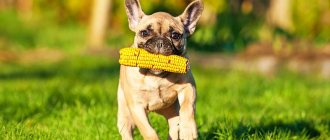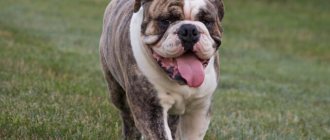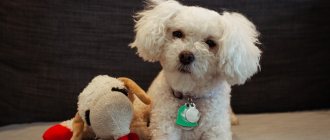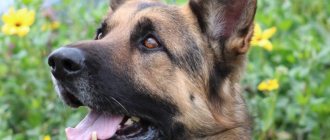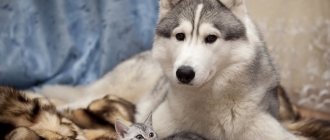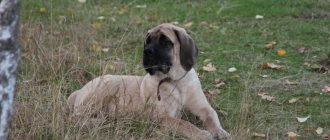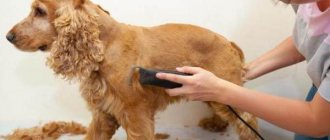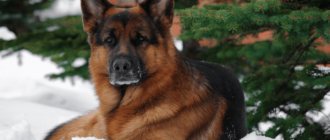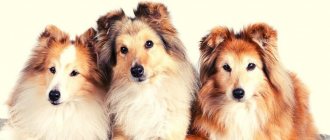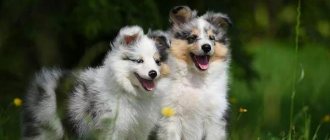History of the French Bulldog breed
French Bulldog
French bulldogs, despite their name, were bred in England. In the 19th century, breeders decided to create a breed of companion dog that could be kept in urban environments without much difficulty. Craftsmen, seamstresses, and lacemakers did not miss the opportunity to acquire a mischievous pet that delighted its owners with its easy-going nature and funny habits. To breed such a dog, breeders selected the smallest English bulldogs and crossed them with terriers and pugs. This is how the modern breed appeared.
In the second half of the 19th century, the demand for manual labor decreased greatly due to the rapid development of manufactories. Many English workers moved to France, taking their beloved dogs with them. According to another version, bulldogs were brought here by traders. The good-natured character, ability to catch small rodents and unusually large erect ears instantly attracted the attention of the French public to this breed.
In Paris, the first owners, or rather owners, of small bulldogs were courtesans. There are many photo postcards with naked or semi-naked women posing with their pets. Very quickly, the fashion for these dogs spread in high society, as evidenced by numerous photographs. Since the 80s of the 19th century, a real boom in the popularity of the breed began. At this time, Paris was already the fashion capital of the world, so the whole world soon learned about French bulldogs. In 1890, dogs were brought to the USA, and 7 years later the FBDCA (French Bulldog Club of America) was established.
French bulldog puppy
French bulldogs made their debut to the general public at an English exhibition in 1896, where they won the admiration of many dog breeders. Breeders became interested in breeding these dogs. The popularity of the breed grew rapidly, and in 1913 about a hundred French bulldogs arrived at the Westminster exhibition. These dogs were originally called Bouledogue Francais, but at the beginning of the twentieth century the name was changed to French Bulldog. The Kennel Club recognized the breed as an independent breed in 1905, separating it from the English Bulldogs.
In the 20s of the twentieth century, these cute pets came to the territory of Russia, but since puppies were very expensive, only representatives of the nobility and simply rich people could afford a French bulldog. One of the most famous fans of French bulldogs was Fyodor Chaliapin. Over time, these dogs' popularity has declined, but they still managed to rank #21 in popularity out of 167 breeds registered by the AKC.
There is a beautiful legend that a French bulldog named Gamin de Pycombe, being the pet of one of the Titanic passengers, managed to escape the shipwreck and even find a new owner. However, this is only half the truth - archival records confirm the presence of a bulldog on board, but it did not survive. Since the dog was insured, its owner received an impressive compensation of more than 20 thousand dollars. Another representative of the breed who went down in history under sad circumstances was Ortipo, the favorite of Princess Tatyana Nikolaevna (daughter of Nicholas II). The dog died along with its owner during the execution of the royal family.
Appearance of French Bulldogs
Black French Bulldog with a white belly
The standard for French Bulldogs was developed by the time exhibitions with their participation began. The main criteria allow us to select the best representatives of the breed: healthy, suitable for show and breeding.
Dimensions
These are small, compact dogs. Adult males weigh about 10-15 kg, females - 8-12 kg. The height at the withers is not officially limited by the standard, but usually it does not exceed 25-35 cm.
Wool
The coat of French bulldogs is smooth, shiny and thin, the coat fits well to the body and has no undercoat, so the dog should be insulated for walking in cold weather.
Torso
The French Bulldog has a strong, square build. The back and hind legs are muscular and strong.
Front legs
The forelimbs are somewhat shorter than the hind limbs, which visually makes the dog slightly stooped. Because of this feature, pets love to lie in a funny position - with their hind legs stretched back. The heavy body and short legs do not allow the French Bulldog to swim (it can stay vertical in the water and gets tired quickly).
Head
Wide and square, so the representatives of the breed are prone to snacking. Some puppies are born with an elongated or cleft soft palate.
French bulldog face
Muzzle
French bulldog brindle color
On the forehead there are wrinkles characteristic of the breed, turning closer to the middle into symmetrical concentric folds, the muzzle is short. The small nose is flattened and turned up. The forehead has a convex profile, the neck is covered with folds. The eyes are large, round with a friendly expression. Breathing is difficult, accompanied by sounds similar to grunting.
Ears
The hearing organs are large, erect, and rounded at the ends.
Color options
Fawn, white, black, brindle, spotted, beige, white-brindle, blue (not recognized by all associations), cream.
French standard according to FCI FCI
The International Cynological Federation, which includes Russia, sets the following breed standards for the modern French bulldog:
- A large and strong skull with a slightly pronounced occiput and convex forehead.
- Short muzzle covered with many folds of skin.
- The neck is short, widening towards the shoulders.
- Standing ears located symmetrically.
- Bulldog bite, i.e. the lower jaw comes forward more strongly than the upper jaw. The lips are thick, completely covering the teeth and tongue.
- Elastic dense skin.
- Large round eyes, eyelids shaped like an arc. The eyeballs are bulging.
- A cylindrical chest, barrel-shaped ribs and an elastic belly.
- Short ponytail with a break.
- The front legs are shorter than the hind legs and are pressed against the body with the elbows.
Photo of a French bulldog
Character and habits of the French bulldog
The French Bulldog is a very friendly dog.
Dogs of this breed are great for living with a family. Wonderful character, playfulness and friendliness are what have always made French bulldogs so popular. Pets love all family members, big and small. At a young age, this is an active and temperamental dog; over time, it becomes slower and more imposing. The French Bulldog craves constant attention from its owner, active games and affection, so it is not recommended for older or overly busy people to own it.
Its cheerful character, ability to do without long walks and ease of care make the pet a good option for inexperienced dog owners. Such a companion will be happy to entertain family members and guests, brightening up even the most gloomy day. The French bulldog senses mood well, so if the owner is feeling bad, he will try to please him or just sit next to him. Despite its compact dimensions, the dog is ready to stand up for itself and its owner in the event of a threat from other people or animals.
Dogs of this breed do not like to be left alone for a long time. The animal begins to feel sad and mischievous; a constant feeling of loneliness can make it more aggressive and wayward. The French Bulldog gets along well with other pets as long as they do not put him on the defensive. But on the street, the Frenchman often conflicts with unfamiliar dogs and cats, so great attention should be paid to training and socialization.
French bulldog with a child
French bulldog with cat
FAQ
Inexperienced dog breeders and those who just got a puppy often don’t know what to do in simple situations. Most problems can be solved without a doctor.
Is it possible to give bones to a French bulldog?
It is not recommended to give regular bones. Representatives of this breed wear down their teeth quickly. Bone fragments can injure your intestines or cause constipation.
How long do French bulldogs live?
The lifespan of a pet depends on the conditions of keeping, care, and nutrition. If he does not have genetic diseases, and is surrounded by love and care at home, he can live longer than the average 12 years.
Do French Bulldogs need to have their tail docked?
These dogs have a short tail and are not docked from birth.
Why glue puppies' ears?
With proper nutrition, the puppy's ears should stand up by 3-4 months. If this does not happen within six months, they are glued under the guidance of a veterinarian.
Why does my pet snore and grunt?
This is due to the peculiarities of the anatomy of the “French”. Due to the unusual structure of the nose and jaws, a dog can make different sounds when breathing.
Is it possible to keep a bulldog in an enclosure?
The French Bulldog can only be kept indoors. If he lives on the street or in an enclosure, he may die from cold and loneliness.
White French bulldog
The French Bulldog is an intelligent, quick-witted and very sociable dog. She is easy to train, persistent and stubborn. The character is balanced and calm, but if you anger her, she becomes dangerous: this dog is very strong, with a good reaction and a strong grip of her jaws.
Education and training
French Bulldogs are not easy to train because they are naturally stubborn and quickly become bored with repetitive actions. Experienced experts advise always using treats for reward, using short training cycles. Especially stubborn representatives of the breed can be trained by building the training process in the form of a game. It is advisable to take a UGS course from a professional dog handler.
French bulldog on a leash
French Bulldogs are sentimental and have a good memory. To help your puppy adapt faster to his new home, ask the breeder for a toy or thing that is already familiar to the baby. Education should begin from the very first day, despite the tender age of your four-legged friend. Do not succumb to the charm of pretty eyes - calmly but firmly indicate your own leadership. Otherwise, it will be extremely difficult to deal with the dog in the future - adult dogs practically do not change their character throughout their lives. Immediately show the dog the tray (toilet), the place where his bowl is located, the area for games and rest. You can quickly teach your baby the commands “Come”, “No” and “Fu”. These are basic orders that will help you communicate with your dog, even if you are not going to train him in any special way.
Until about 8 months, the puppy will actively test the owner’s strength, trying to gain leadership. Strictly suppress hooliganism and aggression, but never hit the dog, avoid shouting and profanity. A powerful voice is enough to punish. If the puppy does everything correctly, do not forget to praise him, surround the pet with care - this will speed up the learning process and prevent anger. Soon the dog will finally come to terms with the main role of man, becoming a devoted friend.
The French Bulldog's worldview and character are fully formed by the age of 16 weeks. Until this moment, it is important to socialize the pet as best as possible, teach commands, and accustom it to hygiene and cosmetic procedures.
Minuses
Pets also have disadvantages, but problems can be avoided with proper upbringing. What negative characteristics are typical of the “French”:
- sometimes they are very active, playful, and can turn the whole house over;
- they remember the insult for a long time and can take revenge;
- due to a rude attitude they become aggressive and can bite;
- cannot stand loneliness;
- They can be stubborn and lazy.
Training
These are smart, quick-witted and calm animals with good reactions. They are easy to train and participate in agility and other canine sports. The peculiarity of dogs from the French bulldog breed is that they have a sense of humor. Their mischievous expression can be seen even in the photo.
We need to chew this stick...
You need to be patient when training and raising a French Bulldog. The “French” understand commands, but are in no hurry to carry them out. This is a companion dog and can change its behavior according to the situation. She will obey when she understands why it is necessary.
When training, you should ensure that the pet always follows the command. But this must be done without rudeness or punishment. If you don’t do this at least once, the pet will completely stop obeying. It is important to show the animal who is in charge as early as possible.
After the puppy appears in the house, it must be accustomed to a place, a bowl, and a toilet. These dogs are able to walk at home on a diaper. But even in this case, you still need to walk with your pet. He should know at least the basic commands: “place”, “fu”, “come to me”, “sit”. But the “French” quickly understand many words: “walk”, “bring”, “ball” and others.
Care and maintenance
Someone is about to be washed
- Brush your pet 1-2 times a week with a brush for short-haired animals or a special mitten. This will help to give a useful massage, remove dead hair and street dust.
- It is enough to bathe an animal with a special shampoo several times a year. After water procedures, dry the body well with a towel; you can use a hairdryer if the dog is not afraid of it.
- You need to brush your teeth with a specialized toothpaste approximately once a week. This procedure can be replaced by buying your French bulldog special bones that help remove plaque and tartar.
- Check your ears regularly - due to their anatomical structure, little wax accumulates, but dirt and insects easily enter. Clean them once a week with a cotton swab or swab. Remember that there should be no liquid or strong unpleasant odor in the ears.
- It is enough to trim the claws once a month, smoothing the ends with a nail file. Carry out the procedure carefully so as not to catch the capillaries.
- Keep an eye on the skin folds on the face – food particles and dirt often get trapped there. It is necessary to wipe them once a day with a soft, damp cloth to prevent the formation of diaper rash.
- Light colored bulldogs experience a small amount of discharge from the eyes. This is normal, but it is advisable to carefully remove all dirt. If there is increased tearing or clouding of the eyes, contact your veterinarian immediately - an infection or allergy is possible.
- The French bulldog breed is not demanding in terms of physical activity - in a spacious apartment the dog can live with virtually no walks. This greatly simplifies its maintenance in urban environments. But the less the pet moves, the more carefully the menu should be drawn up.
Nutritional Features
French bulldogs require careful selection of their diet, as they are prone to gastrointestinal problems, food allergies and obesity. Choose high-quality ready-made dry food only from holistic and super-premium classes. Buy a bowl for your pet with a vertical stand, adjustable in height, provide access at the level of the dog’s chest. This will make drinking and eating more convenient. Change the water every day and remove any leftover food immediately.
Want to eat
If you are planning natural feeding, follow the list of recommended products:
- raw lean meat, cut into pieces;
- boiled sea fish without bones;
- porridge;
- seasonal vegetables and fruits (primarily green);
- chicken eggs;
- fermented milk products (cause diarrhea in some dogs).
Completely exclude fatty meat, river fish, smoked meats, sweets, baked goods, and gas-forming products (beans, cabbage) from your dog’s diet. Puppies up to 2 months are fed 6 times a day, at 3 months - 5 times a day, at 4-7 months - 4 times, at 8-12 months - 3 times. You can switch to two meals a day per year. Monitor portion sizes as French Bulldogs tend to overeat. Do not give very hot or cold food/drink.
Health and Diseases of the French Bulldog
The life expectancy of dogs of this breed with proper care is 10-13 years. Some individuals reach the age of 14 years or more, but this is rare. In general, French Bulldogs are in fairly good health, although there are a few common health conditions.
Bulldog in a suit
- Skin – if not properly cared for, dermatitis can develop in the skin folds of the muzzle or between the toes.
- Eyes – dogs are prone to conjunctivitis, blepharitis, glaucoma, and cataracts. Sometimes an anomaly such as the third eyelid occurs.
- Back – many pets suffer from intervertebral disc problems. This is due to the fact that the breed was bred using the smallest representatives of English bulldogs, which can hardly be called the standard of health.
- Reproductive system - anatomical features complicate natural insemination and childbirth. Most puppies are delivered by caesarean section.
- Thermoregulation – a flattened muzzle negatively affects heat exchange. Dogs are equally sensitive to heat and frost. Some airlines prohibit these animals from being transported because they often die during flights.
- Breathing – even when awake, French bulldogs emit a light grunt, but at night it can turn into powerful snoring. Obese animals are especially susceptible to this.
- Allergies – Most often, pets are susceptible to food reactions.
Animal breeding
The body structure of male dogs makes natural insemination of a female dog problematic, so for greater guarantee, breeders often resort to artificial insemination.
Due to the puppies' disproportionately large heads and narrow hips, Frenchie bitches are rarely able to give birth on their own; more often they require a caesarean section.
It would not be superfluous to conduct an ultrasound to clarify the number of puppies and their location. It is especially important to know this if labor attempts stop and dead puppies remain in the uterus.
Pregnancy lasts about 63 days, sometimes labor begins earlier or later.
IMPORTANT!
Lack of help during contractions that suddenly begin can lead to the death of the bitch.
How to choose a puppy
If you intend to buy a French Bulldog puppy, take the time to search for a reliable kennel that has been verified by a large number of buyers. This is the only way you can buy a dog:
- thoroughbred;
- without serious genetic defects;
- vaccinated;
- with a stable psyche (not fearful, not aggressive).
Additionally, the new owner receives a puppy card, pedigree and vaccination book. Pay attention to the habits of your future pet. This should be a moderately well-fed puppy, active, courageous, and playful. Ears and eyes should be clean, hair without bald spots. It is recommended to take the baby at the age of 8, even better 10-12 weeks. Be sure to ask about the character and habits of your parents - many traits are passed on genetically.
What affects a puppy's height and body weight?
Factors influencing a dog’s parameters include:
- Genetics - the breed characteristics of the parents, affecting the internal structure of the body.
- Heredity – the presence of diseases that inhibit the development of French bulldogs.
- The climate in the place of residence is a favorable or unsuitable environment for the puppy to live.
- Nutrition – duration of breastfeeding, completeness of the diet.
The fourth factor is of particular importance. A bulldog that feeds on its mother's milk grows faster than its counterpart that is bottle-fed. In the future, nutritious high-calorie food can help avoid dystrophy.
